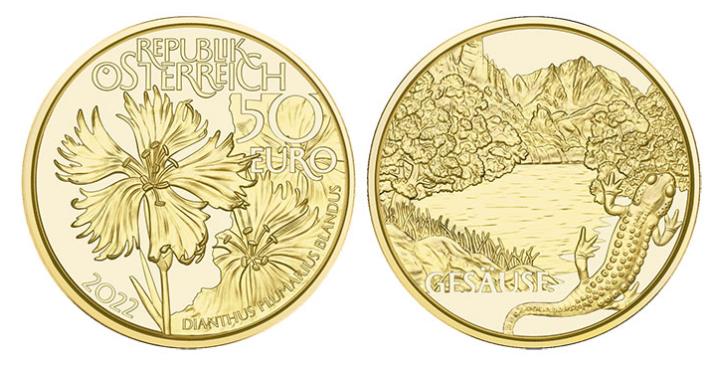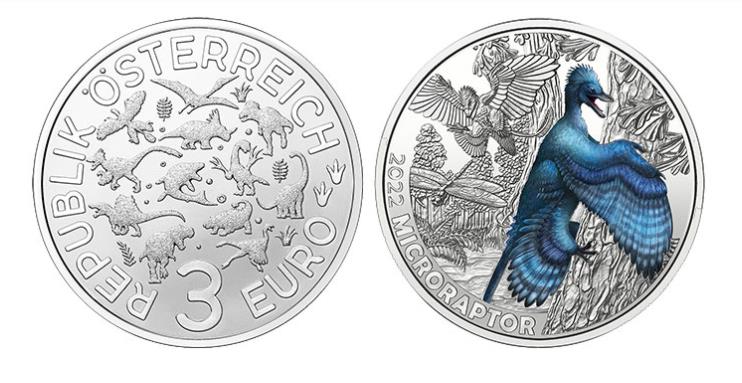The Austrian Mint issued two unique coins in 2022: one from the Alpine Treasure series called Wild Waters, and the other from the Microraptur gui series.
"Alpine Treasures"
Austria is a country of stunningly beautiful landscapes and nature. Here it is customary to protect and maintain environmental balance. There are 7 national parks in Austria. One of the most beautiful parks, Gezoise, was founded in 2002. The park extends along the valley of the Ens River. It is in the federal state of Styria, near the border with Switzerland and Liechtenstein. This park has the biggest elevation difference, almost 1,000 metres, so it has a very diverse nature and landscape.
The park has a large number of endemic species of flora and fauna. Endemic types are representatives of an animal and flora who live in a certain country, the region, the area and do not meet in other parts of the planet. Gezoise is a home for 30 endemic plant species. The most notable flower in the park is carnation. About 195 endemic animal species also live in this wonderful valley. Of particular interest is the alpine salamander, which can be recognized by the yellow stripes on the back. In Austria, this animal is considered an endangered species and is under strict protection. These two unique representatives of the plant and animal world became the basis of the design of the Wild Waters coin.

The obverse of the coin depicts a carnation. On the bottom of the obverse of the coin, around the circle on the right, the Latin name of this type of carnation "DANTHUS PLUMARIUS BLANDUS" is minted, and on the left is the year of issue - "2022." In the upper part of the obverse of the coin, the words "REPUBLIK OSTERREICH" are engraved in large letters. Under this inscription on the right is the face value of the coin - "50 EURO."
The reverse of the coin depicts the incredible beauty landscape of the Gezoise National Park: a unique mountainous area covered with forests, the Ens River, flowing under the huge peaks of Grosser-Odstein (2335 meters high). In the foreground of the reverse of the coin, an alpine salamander crawls. To her right is engraved with her scientific designation.
The coin is made of 0.986 gold as a "proof." The gold content of the coin is ¼ ounces. The circulation of the coin is 20 thousand copies. The coin comes in capsules and in individual cases. It is accompanied by a certificate of authenticity.
'Superzavara'
Dinosaurs were of different shapes and sizes. Microraptor (Latin Microraptor) - belongs to the family of feathered dinosaurs. The remains of microraptors were found at the bottom of a lake in China's Liaoning province. A microraptor is not a bird. However, it is an important link indicating the connection between the evolution of birds and early dinosaurs. Microraptor gui is the smallest dinosaur of this family, weighing about 1 kg. It is one of the few dinosaurs in which archaeologists could establish the color of feathers. Presumably, he hunted trees, rarely going down to the ground. His image was placed on a coin of the same name in the Superzavra series.

On the right side of the reverse of the coin in blue is a microraptor against a forest landscape. He sits on a tree and scratches its trunk. To his left, another microraptor is shown flying and chasing a dragonfly. Both microraptors are beautifully drawn by the artist. The coin clearly shows the characteristic features of this species of dinosaurs: contoured feathers with asymmetric beards, which form wing-like anatomical features not only on the forelimbs, in the tail and even on the hind limbs. This is the key feature of Microraptor gui.
The obverse of the coin depicts the silhouettes of all 12 prehistoric animals that were placed on coins of the Superzavra series. The face value of the coin is 3 euros. It is legal tender in Austria.
The coin is made of copper alloy. Its diameter is 34 mm, and its weight is 16 g. The circulation of the coin is 2 thousand copies.
